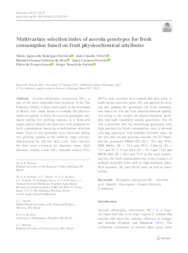Multivariate selection index of acerola genotypes for fresh consumption based on fruit physicochemical attributes.
Multivariate selection index of acerola genotypes for fresh consumption based on fruit physicochemical attributes.
Autoria: FERREIRA, M. A. R.; VILVERT, J. C.; SILVA, B. O. S. da; FERREIRA, I. C.; SOUZA, F. de F.; FREITAS, S. T. de
Resumo: Acerola (Malpighia emarginata DC.) is one of the most important fruit produced in the São Francisco Valley, a Semi-arid region in the Northeast of Brazil. This study aimed to evaluate the physicochemical quality of thirty-fve acerola genotypes produced during two growing seasons in a Semi-arid region and to identify the best ones with potential for fresh consumption based on a multivariate selection index. Fruit of each genotype were harvested during two growing seasons at the maturity stage red-ripe, characterized by full red skin color. After harvest, the fruit were evaluated for diameter, mass, fesh frmness, soluble solids (SS), titratable acidity (TA) SS/TA ratio, ascorbic acid content and skin color. A multivariate selection index (SI) was applied for scoring and ranking the genotypes for fresh consumption based on red-ripe fruit physicochemical quality. According to the results, all physicochemical attributes had high variability among genotypes. The SI was a powerful tool for identifying genotypes with high potential for fresh consumption, since it allowed selecting genotypes with multiple desirable traits. In the frst and second growing seasons, the SI identifed the genotypes PROG 052 (SI = 76.1 and 78.9), BRS Rubra (SI = 74.1 and 99.5), Cabocla (SI = 72.3 and 70.7), Costa Rica (SI = 61.2 and 73.8) and PROG 069 (SI = 68.1 and 72.4) as the most promising ones for fresh consumption due to the presence of multiple desirable traits such as high diameter, mass, fesh frmness, SS, and SS/AT ratio, as well as lower acidity.
Ano de publicação: 2022
Tipo de publicação: Artigo de periódico
Unidade: Embrapa Semiárido
Observações
1 - Por padrão são exibidas publicações dos últimos 20 anos. Para encontrar publicações mais antigas, configure o filtro ano de publicação, colocando o ano a partir do qual você deseja encontrar publicações. O filtro está na coluna da esquerda na busca acima.
2 - Para ler algumas publicações da Embrapa (apenas as que estão em formato ePub), é necessário ter, no celular ou computador, um desses softwares gratuitos. Sistemas Android: Google Play Livros; IOS: iBooks; Windows e Linux: software Calibre.
Acesse outras publicações
Acesse a Base de Dados da Pesquisa Agropecuária (BDPA) para consultar o acervo completo das bibliotecas da Embrapa.

